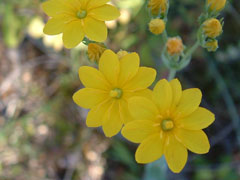 |
|
http://commons.wikimedia.org/wiki/File:Blackstonia_perfoliata-British_Entomology.jpg |
 |
| http://commons.wikimedia.org/wiki/User:Follavoine |
Translate this page:
Summary
Physical Characteristics

 blackstonia perfoliata is a ANNUAL growing to 0.5 m (1ft 8in). It is in flower from June to October. The species is hermaphrodite (has both male and female organs). The plant is self-fertile.
blackstonia perfoliata is a ANNUAL growing to 0.5 m (1ft 8in). It is in flower from June to October. The species is hermaphrodite (has both male and female organs). The plant is self-fertile.
Suitable for: light (sandy) and medium (loamy) soils and prefers well-drained soil. Suitable pH: neutral and basic (mildly alkaline) soils and can grow in very alkaline soils.
It cannot grow in the shade. It prefers dry or moist soil.
UK Hardiness Map
US Hardiness Map
Synonyms
Chlora perfoliata.
Habitats
Meadow;
Edible Uses
References More on Edible Uses
Medicinal Uses
Plants For A Future can not take any responsibility for any adverse effects from the use of plants. Always seek advice from a professional before using a plant medicinally.
None known
References More on Medicinal Uses
Now available: PLANTS FOR YOUR FOOD FOREST: 500 Plants for Temperate Food Forests and Permaculture Gardens.
An important new book from PFAF. It focuses on the attributes of plants suitable for food forests, what each can contribute to a food forest ecosystem, including carbon sequestration, and the kinds of foods they yield. The book suggests that community and small-scale food forests can provide a real alternative to intensive industrialised agriculture, and help to combat the many inter-related environmental crises that threaten the very future of life on Earth.
Read More
Other Uses
Dye
A yellow dye is obtained from the plant extract[61, 141].
Special Uses
References More on Other Uses
Cultivation details
A native plant, we do not have any details on its cultivation but it should succeed in a summer meadow or in a sunny position in a well drained soil. It prefers calcareous soils in the wild[17].
References Carbon Farming Information and Carbon Sequestration Information
Temperature Converter
Type a value in the Celsius field to convert the value to Fahrenheit:
Fahrenheit:
The PFAF Bookshop
Plants For A Future have a number of books available in paperback and digital form. Book titles include Edible Plants, Edible Perennials, Edible Trees, and Woodland Gardening. Our new book to be released soon is Edible Shrubs.
Shop Now
Propagation
Seed - sow early spring in seed pots in a cold frame and plant out as soon as the plants are large enough to handle. When well sited, the plant should self-sow. If you have sufficient seed it should be possible to sow the seed in situ in the spring.
Other Names
If available other names are mentioned here
Native Plant Search
Search over 900 plants ideal for food forests and permaculture gardens. Filter to search native plants to your area. The plants selected are the plants in our book 'Plants For Your Food Forest: 500 Plants for Temperate Food Forests and Permaculture Gardens, as well as plants chosen for our forthcoming related books for Tropical/Hot Wet Climates and Mediterranean/Hot Dry Climates. Native Plant Search
Found In
Countries where the plant has been found are listed here if the information is available
Weed Potential
Right plant wrong place. We are currently updating this section.
Please note that a plant may be invasive in one area but may not in your area so it’s worth checking.
Conservation Status
IUCN Red List of Threatened Plants Status :

Growth: S = slow M = medium F = fast. Soil: L = light (sandy) M = medium H = heavy (clay). pH: A = acid N = neutral B = basic (alkaline). Shade: F = full shade S = semi-shade N = no shade. Moisture: D = dry M = Moist We = wet Wa = water.

Expert comment
Author
(L.)Huds.
Botanical References
17
Links / References
For a list of references used on this page please go here
Readers comment
© 2010, Plants For A Future. Plants For A Future is a charitable company limited by guarantee, registered in England and Wales. Charity No. 1057719, Company No. 3204567.